HBR.ORG
NOVEMBER 2014
REPRINT R1411C
SPOTLIGHT ON MANAGING THE INTERNET OF THINGS
How Smart,
Connected Products
Are Transforming
Competition
by Michael E. Porter and James E. Heppelmann
This HBR article is made available to you with compliments of PTC Inc. Further posting, copying or distributing is copyright infringement.
�
SPOTLIGHT ON MANAGING THE INTERNET OF THINGS
SPOTLIGHT
ARTWORK Chris Labrooy
Braun, Toaster
This HBR article is made available to you with compliments of PTC Inc. Further posting, copying or distributing is copyright infringement.
�
FOR ARTICLE REPRINTS CALL 800-988-0886 OR 617-783-7500, OR VISIT HBR.ORG
Michael E. Porter is the
Bishop William Lawrence
University Professor, based
at Harvard Business School.
James E. Heppelmann
is the president and CEO
of PTC, a Massachusetts-
based software company
that helps manufacturers
create, operate, and
service products.
How Smart,
Connected Products
Are Transforming
Competition
by Michael E. Porter and James E. Heppelmann
This HBR article is made available to you with compliments of PTC Inc. Further posting, copying or distributing is copyright infringement.
November 2014 Harvard Business Review 3
�
SPOTLIGHT ON MANAGING THE INTERNET OF THINGS
I
nformation technology is revolutionizing
products. Once composed solely of mechanical
and electrical parts, products have become
complex systems that combine hardware,
sensors, data storage, microprocessors,
software, and connectivity in myriad ways.
These “smart, connected products”—made
possible by vast improvements in processing power and device
miniaturization and by the network benefits of ubiquitous wireless
connectivity—have unleashed a new era of competition.
Smart, connected products offer exponentially
expanding opportunities for new functionality, far
greater reliability, much higher product utilization,
and capabilities that cut across and transcend tra-
ditional product boundaries. The changing nature
of products is also disrupting value chains, forcing
companies to rethink and retool nearly everything
they do internally.
These new types of products alter industry struc-
ture and the nature of competition, exposing com-
panies to new competitive opportunities and threats.
They are reshaping industry boundaries and creating
entirely new industries. In many companies, smart,
connected products will force the fundamental
question, “What business am I in?”
Smart, connected products raise a new set of stra-
tegic choices related to how value is created and cap-
tured, how the prodigious amount of new (and sensi-
tive) data they generate is utilized and managed, how
relationships with traditional business partners such
as channels are redefined, and what role companies
should play as industry boundaries are expanded.
The phrase “internet of things” has arisen to
reflect the growing number of smart, connected
products and highlight the new opportunities they
can represent. Yet this phrase is not very helpful in
understanding the phenomenon or its implications.
The internet, whether involving people or things, is
simply a mechanism for transmitting information.
What makes smart, connected products fundamen-
tally different is not the internet, but the changing
nature of the “things.” It is the expanded capabilities
of smart, connected products and the data they gen-
erate that are ushering in a new era of competition.
Companies must look beyond the technologies
themselves to the competitive transformation tak-
ing place. This article, and a companion piece to be
published soon in HBR, will deconstruct the smart,
connected products revolution and explore its stra-
tegic and operational implications.
The Third Wave of IT-Driven
Competition
Twice before over the past 50 years, information
technology radically reshaped competition and
strategy; we now stand at the brink of a third trans-
formation. Before the advent of modern information
technology, products were mechanical and activities
in the value chain were performed using manual, pa-
per processes and verbal communication. The first
wave of IT, during the 1960s and 1970s, automated
individual activities in the value chain, from order
processing and bill paying to computer-aided design
and manufacturing resource planning. (See “How
Information Gives You Competitive Advantage,” by
Michael Porter and Victor Millar, HBR, July 1985.)
The productivity of activities dramatically increased,
in part because huge amounts of new data could be
captured and analyzed in each activity. This led to
the standardization of processes across companies—
and raised a dilemma for companies about how to
capture IT’s operational benefits while maintaining
distinctive strategies.
The rise of the internet, with its inexpensive and
ubiquitous connectivity, unleashed the second wave
of IT-driven transformation, in the 1980s and 1990s
(see Michael Porter’s “Strategy and the Internet,”
HBR, March 2001). This enabled coordination and
INSIGHT CENTER Find
our monthlong series of
articles on the internet
of things at hbr.org/
insights/iot.
4 Harvard Business Review November 2014
This HBR article is made available to you with compliments of PTC Inc. Further posting, copying or distributing is copyright infringement.
COPYRIGHT © 2014 HARVARD BUSINESS SCHOOL PUBLISHING CORPORATION. ALL RIGHTS RESERVED.
�
FOR ARTICLE REPRINTS CALL 800-988-0886 OR 617-783-7500, OR VISIT HBR.ORG
Idea in Brief
A CHANGING ENVIRONMENT
Smart, connected products
offer exponentially expanding
opportunities for new
functionality and capabilities
that transcend traditional
product boundaries.
The changing nature of
products is disrupting value
chains and forcing companies
to rethink nearly everything
they do, from how they
conceive, design, and
source products; to how
they manufacture, operate,
and service them; to how
they build and secure the
necessary IT infrastructure.
THE NEW STRATEGIC CHOICES
Smart, connected products
raise a new set of strategic
choices about how value
is created and captured,
how companies work with
traditional and new partners,
and how they secure
competitive advantage as
the new capabilities reshape
industry boundaries. For
many firms, smart, connected
products will force the
fundamental question,
“What business am I in?”
This article provides a
framework for developing
strategy and achieving
competitive advantage
in a smart, connected world.
integration across individual activities; with out-
side suppliers, channels, and customers; and across
geography. It allowed firms, for example, to closely
integrate globally distributed supply chains.
The first two waves gave rise to huge productiv-
ity gains and growth across the economy. While the
value chain was transformed, however, products
themselves were largely unaffected.
Now, in the third wave, IT is becoming an integral
part of the product itself. Embedded sensors, proces-
sors, software, and connectivity in products (in effect,
computers are being put inside products), coupled
with a product cloud in which product data is stored
and analyzed and some applications are run, are driv-
ing dramatic improvements in product functionality
and performance. Massive amounts of new product-
usage data enable many of those improvements.
Another leap in productivity in the economy will
be unleashed by these new and better products. In
addition, producing them will reshape the value
chain yet again, by changing product design, market-
ing, manufacturing, and after-sale service and by cre-
ating the need for new activities such as product data
analytics and security. This will drive yet another
wave of value-chain-based productivity improve-
ment. The third wave of IT-driven transformation
thus has the potential to be the biggest yet, triggering
even more innovation, productivity gains, and eco-
nomic growth than the previous two.
Some have suggested that the internet of things
“changes everything,” but that is a dangerous over-
simplification. As with the internet itself, smart, con-
nected products reflect a whole new set of techno-
logical possibilities that have emerged. But the rules
of competition and competitive advantage remain
the same. Navigating the world of smart, connected
products requires that companies understand these
rules better than ever.
What Are Smart,
Connected Products?
Smart, connected products have three core ele-
ments: physical components, “smart” components,
and connectivity components. Smart components
amplify the capabilities and value of the physical
components, while connectivity amplifies the ca-
pabilities and value of the smart components and
enables some of them to exist outside the physical
product itself. The result is a virtuous cycle of value
improvement.
Physical components comprise the product’s
mechanical and electrical parts. In a car, for example,
these include the engine block, tires, and batteries.
Smart components comprise the sensors, mi-
croprocessors, data storage, controls, software, and,
typically, an embedded operating system and en-
hanced user interface. In a car, for example, smart
components include the engine control unit, anti-
lock braking system, rain-sensing windshields with
automated wipers, and touch screen displays. In
many products, software replaces some hardware
components or enables a single physical device to
perform at a variety of levels.
Connectivity components comprise the ports,
antennae, and protocols enabling wired or wireless
connections with the product. Connectivity takes
three forms, which can be present together:
• One-to-one: An individual product connects to
the user, the manufacturer, or another product
through a port or other interface—for example,
when a car is hooked up to a diagnostic machine.
• One-to-many: A central system is continuously or
intermittently connected to many products simul-
taneously. For example, many Tesla automobiles
are connected to a single manufacturer system
that monitors performance and accomplishes re-
mote service and upgrades.
This HBR article is made available to you with compliments of PTC Inc. Further posting, copying or distributing is copyright infringement.
November 2014 Harvard Business Review 5
�
SPOTLIGHT ON MANAGING THE INTERNET OF THINGS
• Many-to-many: Multiple products connect to
many other types of products and often also to
external data sources. An array of types of farm
equipment are connected to one another, and to
geolocation data, to coordinate and optimize the
farm system. For example, automated tillers inject
nitrogen fertilizer at precise depths and intervals,
and seeders follow, placing corn seeds directly in
the fertilized soil.
Some have suggested that the
internet of things “changes
everything,” but that is a
dangerous oversimplification.
The rules of competition and
competitive advantage still apply.
Connectivity serves a dual purpose. First, it al-
lows information to be exchanged between the
product and its operating environment, its maker, its
users, and other products and systems. Second, con-
nectivity enables some functions of the product to
exist outside the physical device, in what is known
as the product cloud. For example, in Bose’s new
Wi-Fi system, a smartphone application running in
the product cloud streams music to the system from
the internet. To achieve high levels of functionality,
all three types of connectivity are necessary.
Smart, connected products are emerging across
all manufacturing sectors. In heavy machinery,
Schindler’s PORT Technology reduces elevator
wait times by as much as 50% by predicting eleva-
tor demand patterns, calculating the fastest time to
destination, and assigning the appropriate elevator
to move passengers quickly. In the energy sector,
ABB’s smart grid technology enables utilities to ana-
lyze huge amounts of real-time data across a wide
range of generating, transforming, and distribution
equipment (manufactured by ABB as well as others),
such as changes in the temperature of transformers
and secondary substations. This alerts utility control
centers to possible overload conditions, allowing
This technology enables not only rapid product
application development and operation but the col-
lection, analysis, and sharing of the potentially huge
amounts of longitudinal data generated inside and
outside the products that has never been available
before. Building and supporting the technology
stack for smart, connected products requires sub-
stantial investment and a range of new skills—such
6 Harvard Business Review November 2014
This HBR article is made available to you with compliments of PTC Inc. Further posting, copying or distributing is copyright infringement.
adjustments that can prevent blackouts before they
occur. In consumer goods, Big Ass ceiling fans sense
and engage automatically when a person enters a
room, regulate speed on the basis of temperature
and humidity, and recognize individual user prefer-
ences and adjust accordingly.
Why now? An array of innovations across the
technology landscape have converged to make
smart, connected products technically and eco-
nomically feasible. These include breakthroughs
in the performance, miniaturization, and energy
efficiency of sensors and batteries; highly compact,
low-cost computer processing power and data stor-
age, which make it feasible to put computers inside
products; cheap connectivity ports and ubiquitous,
low-cost wireless connectivity; tools that enable
rapid software development; big data analytics; and
a new IPv6 internet registration system opening up
340 trillion trillion trillion potential new internet ad-
dresses for individual devices, with protocols that
support greater security, simplify handoffs as de-
vices move across networks, and allow devices to
request addresses autonomously without the need
for IT support.
Smart, connected products require that compa-
nies build an entirely new technology infrastructure,
consisting of a series of layers known as a “technol-
ogy stack” (see the exhibit “The New Technology
Stack”). This includes modified hardware, software
applications, and an operating system embedded
in the product itself; network communications to
support connectivity; and a product cloud (soft-
ware running on the manufacturer’s or a third-party
server) containing the product-data database, a
platform for building software applications, a rules
engine and analytics platform, and smart product
applications that are not embedded in the product.
Cutting across all the layers is an identity and se-
curity structure, a gateway for accessing external
data, and tools that connect the data from smart,
connected products to other business systems (for
example, ERP and CRM systems).
�
FOR ARTICLE REPRINTS CALL 800-988-0886 OR 617-783-7500, OR VISIT HBR.ORG
THE NEW TECHNOLOGY STACK
Smart, connected products require companies to build and support an entirely new technology
infrastructure. This “technology stack” is made up of multiple layers, including new product hardware,
embedded software, connectivity, a product cloud consisting of software running on remote servers,
a suite of security tools, a gateway for external information sources, and integration with enterprise
business systems.
PRODUCT CLOUD
Smart Product Applications
Software applications running on remote servers that manage the monitoring,
control, optimization, and autonomous operation of product functions
The rules, business logic, and big data analytical capabilities that populate
the algorithms involved in product operation and reveal new product insights
Rules/Analytics Engine
Identity and
Security
Tools that
manage user
authentication
and system
access, as
well as secure
the product,
connectivity, and
product cloud
layers
Application Platform
An application development and execution environment enabling the rapid
creation of smart, connected business applications using data access,
visualization, and run-time tools
Product Data Database
A big-data database system that enables aggregation, normalization,
and management of real-time and historical product data
CONNECTIVITY
The protocols that enable communications between the product and the cloud
Network Communication
Integration
with Business
Systems
Tools that
integrate data
from smart,
connected
products with
core enterprise
business systems
such as ERP, CRM,
and PLM
External
Information
Sources
A gateway for
information
from external
sources—such as
weather, traffic,
commodity and
energy prices,
social media,
and geo-
mapping—that
informs product
capabilities
PRODUCT
Product Software
An embedded operating system, onboard software applications,
an enhanced user interface, and product control components
Product Hardware
Embedded sensors, processors, and a connectivity port/antenna that
supplement traditional mechanical and electrical components
as software development, systems engineering, data
analytics, and online security expertise—that are
rarely found in manufacturing companies.
What Can Smart,
Connected Products Do?
Intelligence and connectivity enable an entirely new
set of product functions and capabilities, which can
be grouped into four areas: monitoring, control, op-
timization, and autonomy. A product can potentially
incorporate all four (see the exhibit “Capabilities of
Smart, Connected Products”). Each capability is
valuable in its own right and also sets the stage for
the next level. For example, monitoring capabilities
are the foundation for product control, optimization,
and autonomy. A company must choose the set of ca-
pabilities that deliver its customer value and define
its competitive positioning.
Monitoring. Smart, connected products en-
able the comprehensive monitoring of a product’s
This HBR article is made available to you with compliments of PTC Inc. Further posting, copying or distributing is copyright infringement.
November 2014 Harvard Business Review 7
�
a patient reaches a threshold blood-glucose level, en-
abling appropriate therapy adjustments.
Monitoring capabilities can span multiple prod-
ucts across distances. Joy Global, a leading mining
equipment manufacturer, monitors operating con-
ditions, safety parameters, and predictive service
indicators for entire fleets of equipment far under-
ground. Joy also monitors operating parameters
across multiple mines in different countries for
benchmarking purposes.
Control. Smart, connected products can be con-
trolled through remote commands or algorithms
that are built into the device or reside in the product
cloud. Algorithms are rules that direct the pro-
duct to respond to specified changes in its condition
or environment (for example, “if pressure gets too
high, shut off the valve” or “when traffic in a park-
ing garage reaches a certain level, turn the overhead
lighting on or off”).
SPOTLIGHT ON MANAGING THE INTERNET OF THINGS
condition, operation, and external environment
through sensors and external data sources. Using
data, a product can alert users or others to changes
in circumstances or performance. Monitoring also al-
lows companies and customers to track a product’s
operating characteristics and history and to better un-
derstand how the product is actually used. This data
has important implications for design (by reducing
overengineering, for example), market segmentation
(through the analysis of usage patterns by customer
type), and after-sale service (by allowing the dispatch
of the right technician with the right part, thus im-
proving the first-time fix rate). Monitoring data may
also reveal warranty compliance issues as well as new
sales opportunities, such as the need for additional
product capacity because of high utilization.
In some cases, such as medical devices, monitor-
ing is the core element of value creation. Medtronic’s
digital blood-glucose meter uses a sensor inserted
under the patient’s skin to measure glucose levels in
tissue fluid and connects wirelessly to a device that
alerts patients and clinicians up to 30 minutes before
Control through software embedded in the prod-
uct or the cloud allows the customization of product
performance to a degree that previously was not cost
CAPABILITIES OF SMART,
CONNECTED PRODUCTS
The capabilities of smart, connected products can
be grouped into four areas: monitoring, control,
optimization, and autonomy. Each builds on the
preceding one; to have control capability, for example,
a product must have monitoring capability.
Control
2
Software embedded in the
product or in the product
cloud enables:
• Control of product functions
• Personalization of the user
experience
1
Monitoring
Sensors and external
data sources enable the
comprehensive monitoring of:
• the product’s condition
• the external environment
• the product’s operation
and usage
Monitoring also enables alerts
and notifications of changes
Optimization
Autonomy
4
3
Monitoring and control
capabilities enable algorithms
that optimize product
operation and use in order to:
• Enhance product
performance
• Allow predictive diagnostics,
service, and repair
Combining monitoring, control,
and optimization allows:
• Autonomous product
operation
• Self-coordination of
operation with other
products and systems
• Autonomous product
enhancement and
personalization
• Self-diagnosis and
service
8 Harvard Business Review November 2014
This HBR article is made available to you with compliments of PTC Inc. Further posting, copying or distributing is copyright infringement.
�

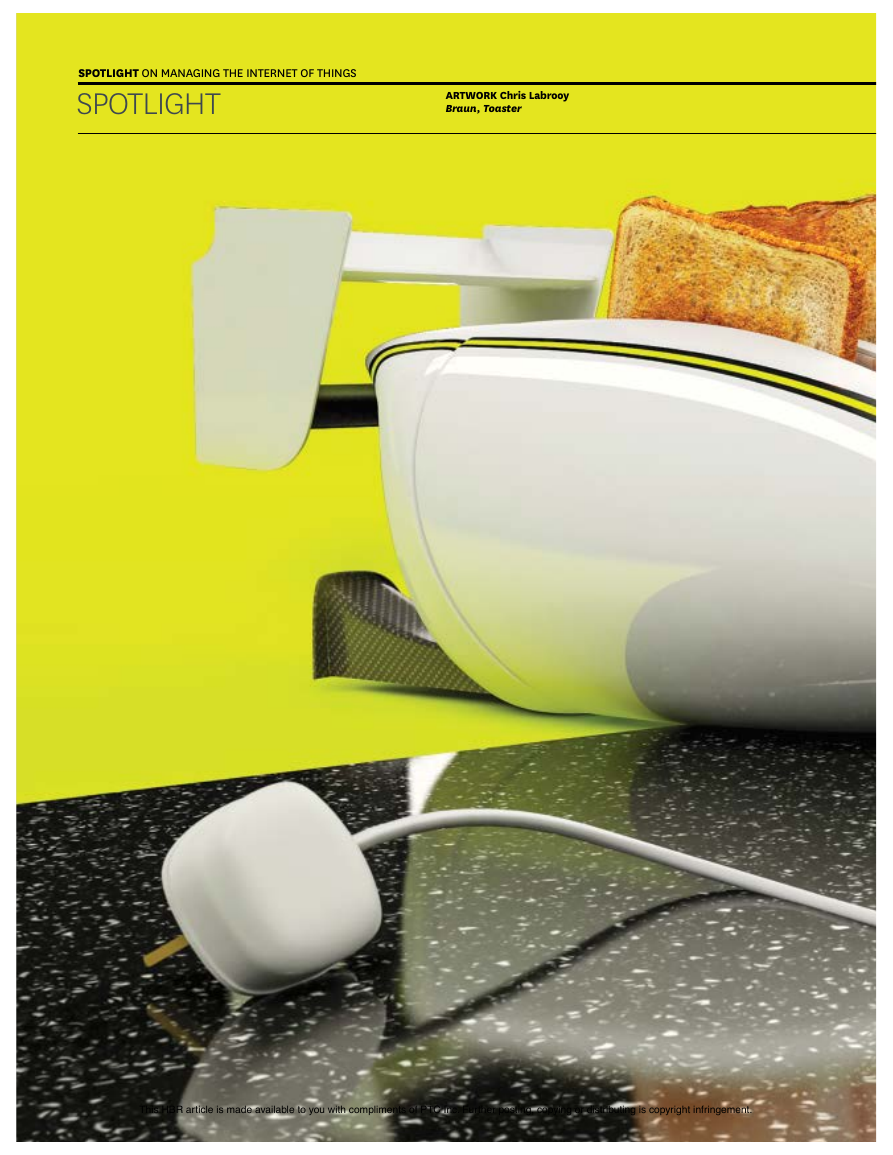
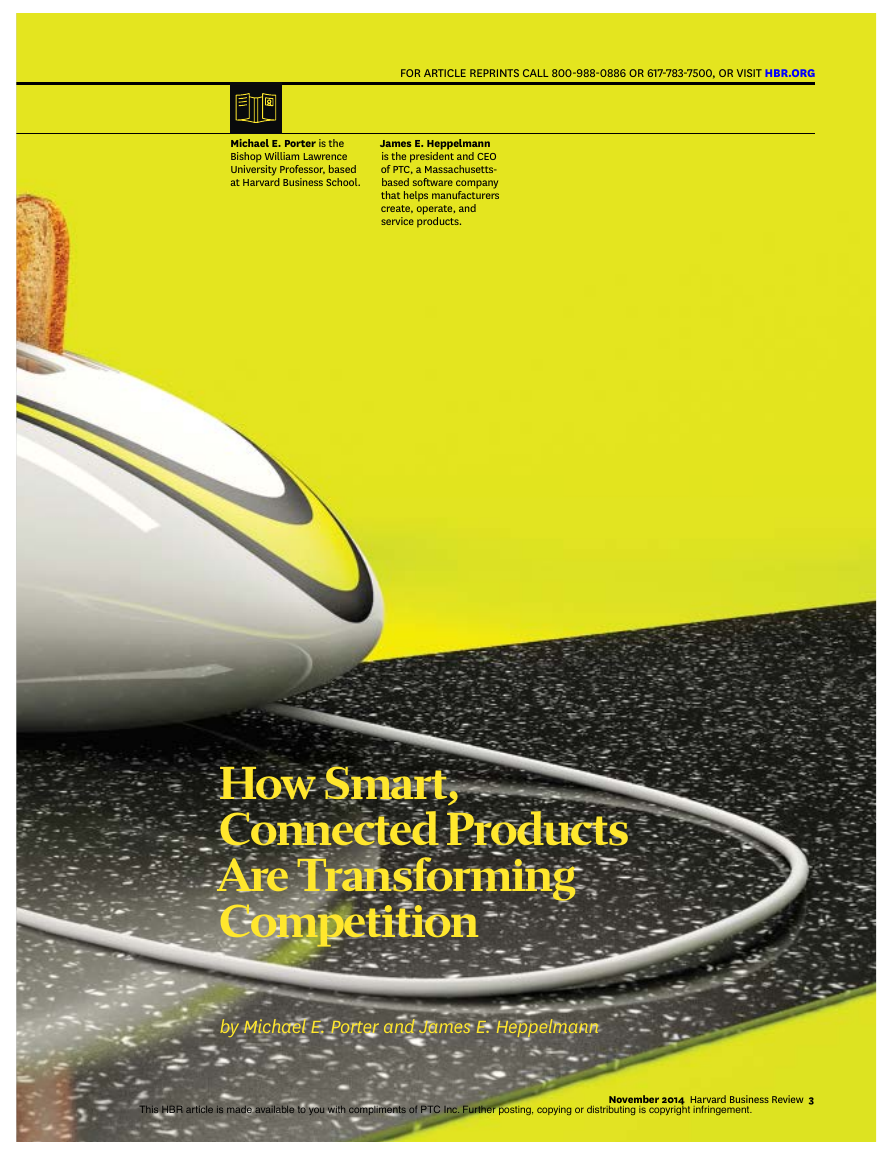
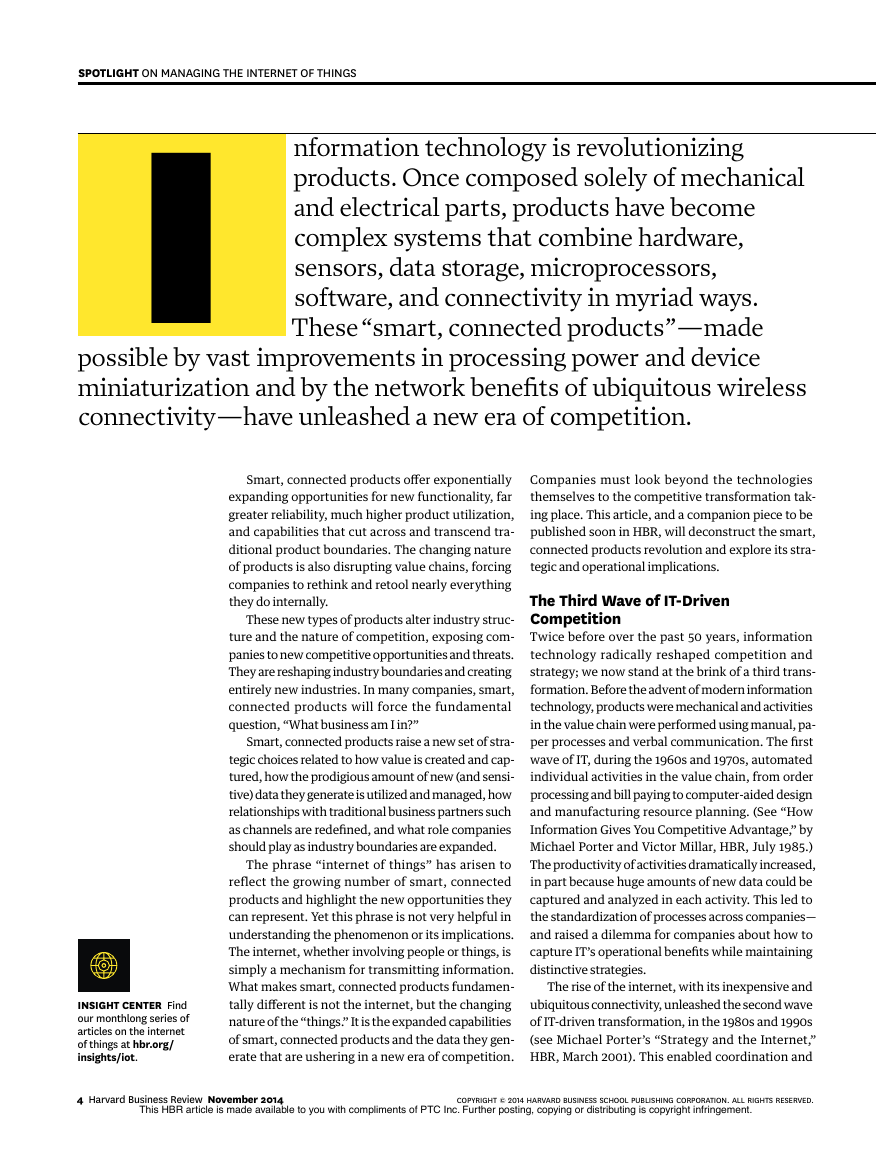
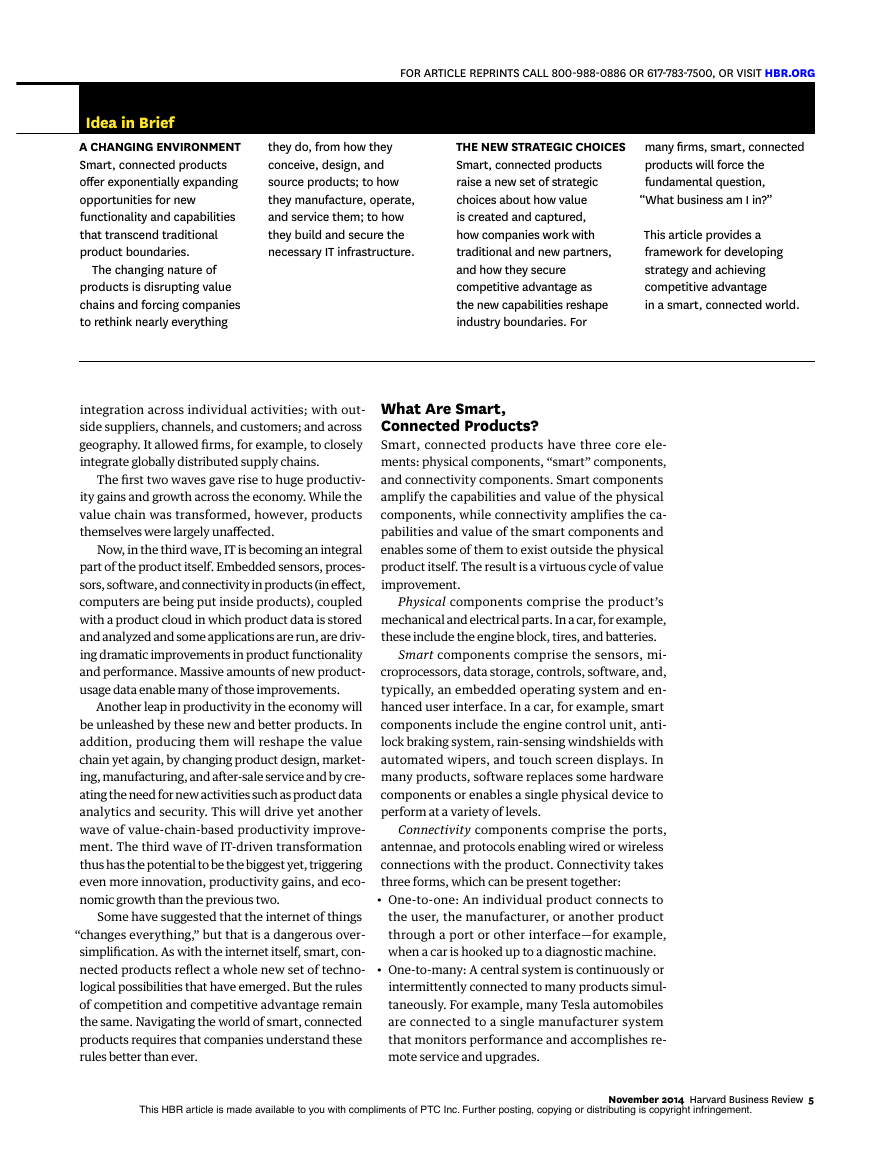
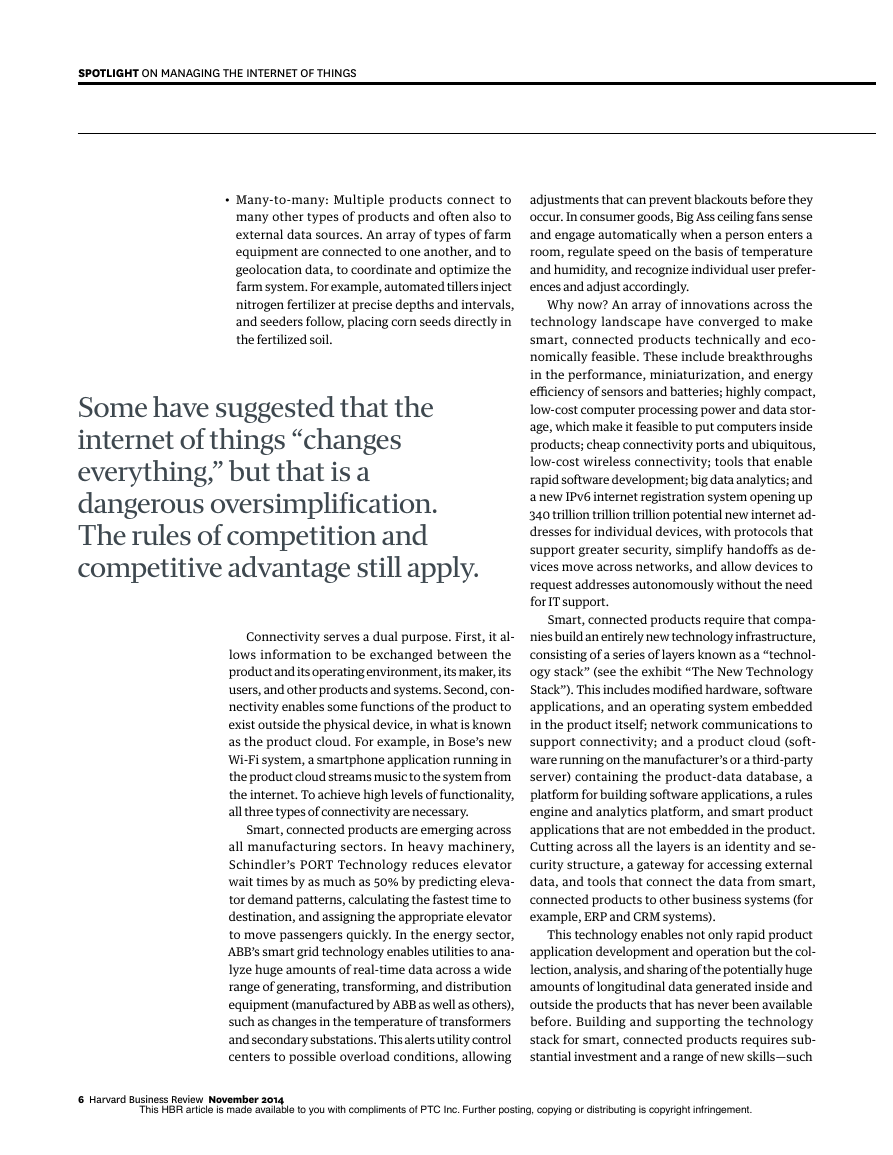
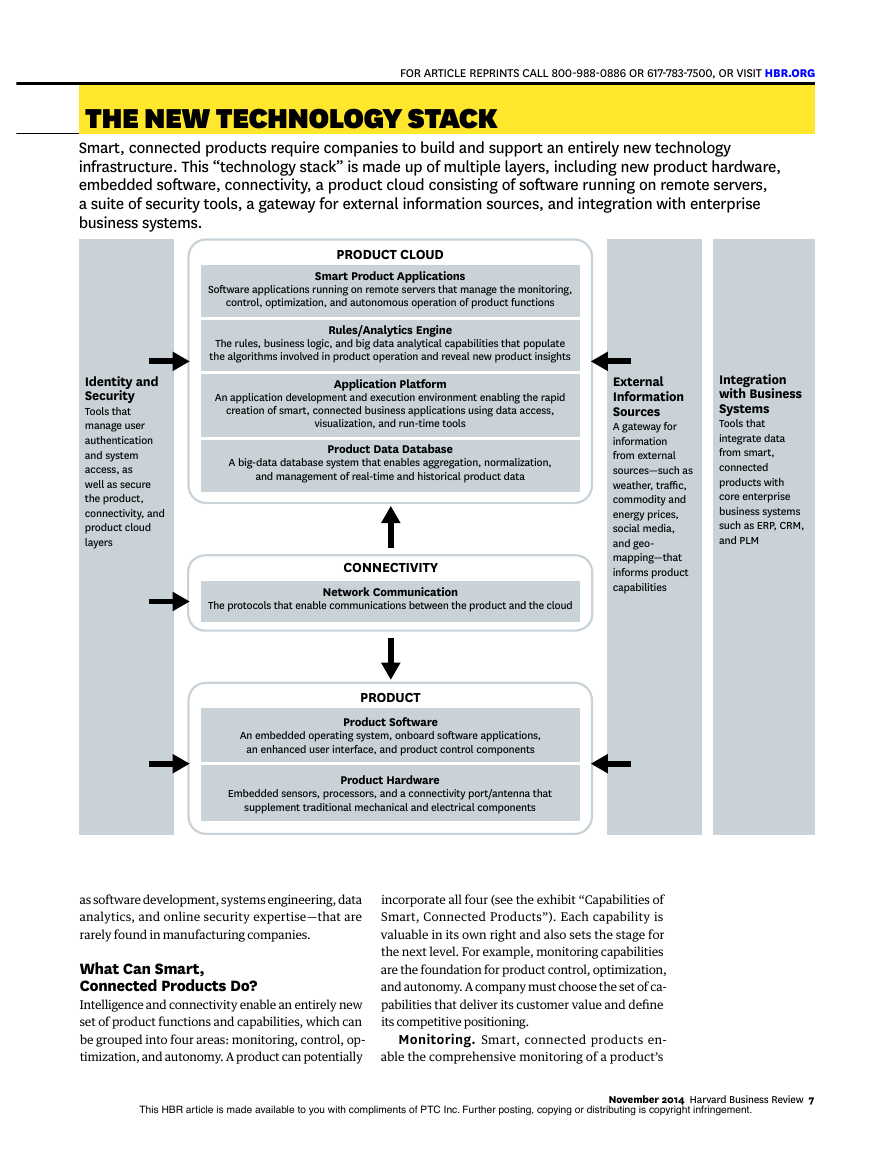
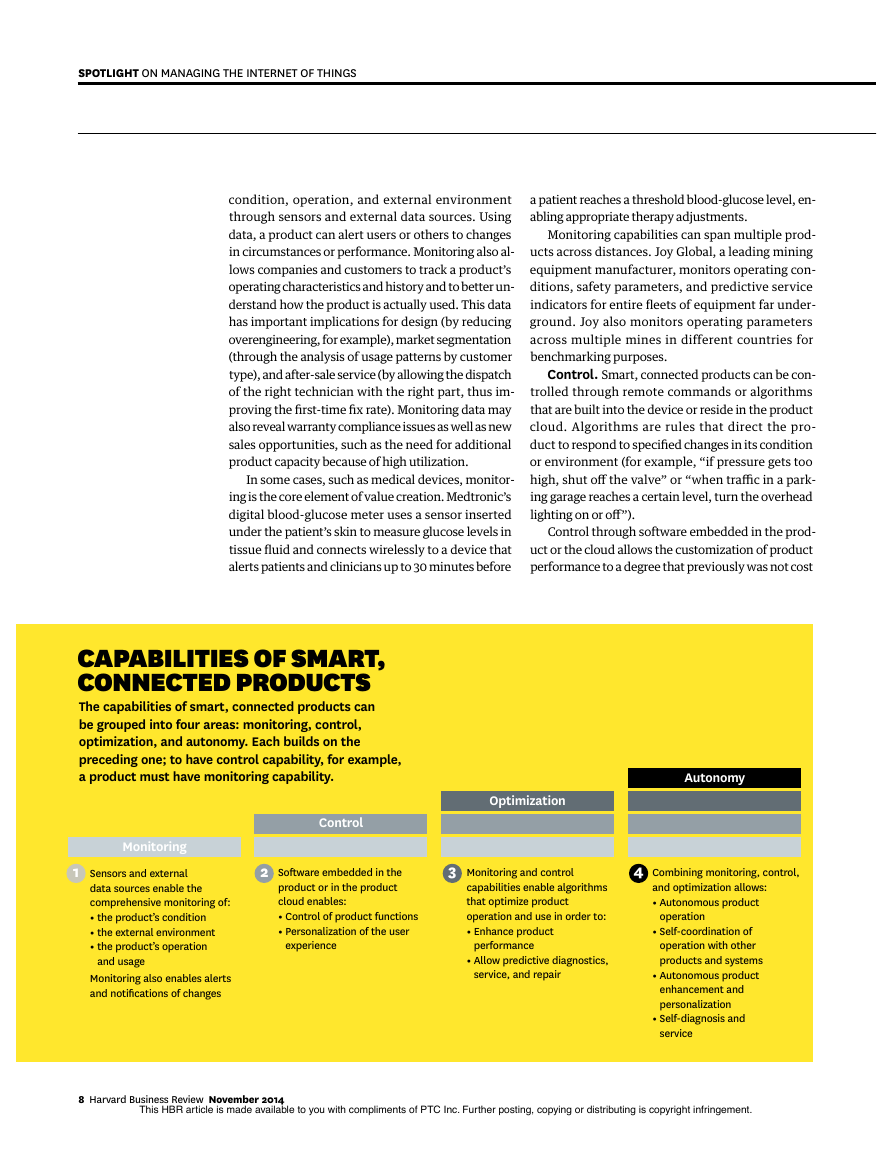








 2023年江西萍乡中考道德与法治真题及答案.doc
2023年江西萍乡中考道德与法治真题及答案.doc 2012年重庆南川中考生物真题及答案.doc
2012年重庆南川中考生物真题及答案.doc 2013年江西师范大学地理学综合及文艺理论基础考研真题.doc
2013年江西师范大学地理学综合及文艺理论基础考研真题.doc 2020年四川甘孜小升初语文真题及答案I卷.doc
2020年四川甘孜小升初语文真题及答案I卷.doc 2020年注册岩土工程师专业基础考试真题及答案.doc
2020年注册岩土工程师专业基础考试真题及答案.doc 2023-2024学年福建省厦门市九年级上学期数学月考试题及答案.doc
2023-2024学年福建省厦门市九年级上学期数学月考试题及答案.doc 2021-2022学年辽宁省沈阳市大东区九年级上学期语文期末试题及答案.doc
2021-2022学年辽宁省沈阳市大东区九年级上学期语文期末试题及答案.doc 2022-2023学年北京东城区初三第一学期物理期末试卷及答案.doc
2022-2023学年北京东城区初三第一学期物理期末试卷及答案.doc 2018上半年江西教师资格初中地理学科知识与教学能力真题及答案.doc
2018上半年江西教师资格初中地理学科知识与教学能力真题及答案.doc 2012年河北国家公务员申论考试真题及答案-省级.doc
2012年河北国家公务员申论考试真题及答案-省级.doc 2020-2021学年江苏省扬州市江都区邵樊片九年级上学期数学第一次质量检测试题及答案.doc
2020-2021学年江苏省扬州市江都区邵樊片九年级上学期数学第一次质量检测试题及答案.doc 2022下半年黑龙江教师资格证中学综合素质真题及答案.doc
2022下半年黑龙江教师资格证中学综合素质真题及答案.doc